+ Open data
Open data
- Basic information
Basic information
| Entry | Database: PDB / ID: 1ovl | ||||||
|---|---|---|---|---|---|---|---|
| Title | Crystal Structure of Nurr1 LBD | ||||||
 Components Components | (Orphan nuclear receptor NURR1 (MSE ...) x 2 | ||||||
 Keywords Keywords | TRANSCRIPTION / Nuur1 / LBD | ||||||
| Function / homology |  Function and homology information Function and homology informationgeneral adaptation syndrome / habenula development / cellular response to corticotropin-releasing hormone stimulus / central nervous system projection neuron axonogenesis / nuclear glucocorticoid receptor binding / regulation of dopamine metabolic process / regulation of respiratory gaseous exchange / midbrain dopaminergic neuron differentiation / dopaminergic neuron differentiation / neuron maturation ...general adaptation syndrome / habenula development / cellular response to corticotropin-releasing hormone stimulus / central nervous system projection neuron axonogenesis / nuclear glucocorticoid receptor binding / regulation of dopamine metabolic process / regulation of respiratory gaseous exchange / midbrain dopaminergic neuron differentiation / dopaminergic neuron differentiation / neuron maturation / central nervous system neuron differentiation / dopamine biosynthetic process / fat cell differentiation / negative regulation of apoptotic signaling pathway / canonical Wnt signaling pathway / nuclear retinoid X receptor binding / response to amphetamine / adult locomotory behavior / post-embryonic development / SUMOylation of intracellular receptors / beta-catenin binding / Nuclear Receptor transcription pathway / nuclear receptor activity / neuron migration / sequence-specific double-stranded DNA binding / cellular response to oxidative stress / DNA-binding transcription activator activity, RNA polymerase II-specific / neuron apoptotic process / transcription regulator complex / negative regulation of neuron apoptotic process / transcription by RNA polymerase II / DNA-binding transcription factor activity, RNA polymerase II-specific / response to hypoxia / nuclear speck / RNA polymerase II cis-regulatory region sequence-specific DNA binding / protein heterodimerization activity / DNA-templated transcription / regulation of transcription by RNA polymerase II / chromatin / negative regulation of transcription by RNA polymerase II / positive regulation of transcription by RNA polymerase II / protein-containing complex / DNA binding / zinc ion binding / nucleoplasm / nucleus / cytoplasm Similarity search - Function | ||||||
| Biological species |  Homo sapiens (human) Homo sapiens (human) | ||||||
| Method |  X-RAY DIFFRACTION / X-RAY DIFFRACTION /  SYNCHROTRON / SYNCHROTRON /  MAD / Resolution: 2.2 Å MAD / Resolution: 2.2 Å | ||||||
 Authors Authors | Wang, Z. / Liu, J. / Walker, N. | ||||||
 Citation Citation |  Journal: Nature / Year: 2003 Journal: Nature / Year: 2003Title: Structure and Function of Nurr1 identifies a Class of Ligand-Independent Nuclear Receptors Authors: Wang, Z. / Benoit, G. / Liu, J. / Prasad, S. / Aarnisalo, P. / Liu, X. / Xu, H. / Walker, N. / Perlmann, T. | ||||||
| History |
|
- Structure visualization
Structure visualization
| Structure viewer | Molecule:  Molmil Molmil Jmol/JSmol Jmol/JSmol |
|---|
- Downloads & links
Downloads & links
- Download
Download
| PDBx/mmCIF format |  1ovl.cif.gz 1ovl.cif.gz | 295.2 KB | Display |  PDBx/mmCIF format PDBx/mmCIF format |
|---|---|---|---|---|
| PDB format |  pdb1ovl.ent.gz pdb1ovl.ent.gz | 237.7 KB | Display |  PDB format PDB format |
| PDBx/mmJSON format |  1ovl.json.gz 1ovl.json.gz | Tree view |  PDBx/mmJSON format PDBx/mmJSON format | |
| Others |  Other downloads Other downloads |
-Validation report
| Arichive directory |  https://data.pdbj.org/pub/pdb/validation_reports/ov/1ovl https://data.pdbj.org/pub/pdb/validation_reports/ov/1ovl ftp://data.pdbj.org/pub/pdb/validation_reports/ov/1ovl ftp://data.pdbj.org/pub/pdb/validation_reports/ov/1ovl | HTTPS FTP |
|---|
-Related structure data
| Similar structure data |
|---|
- Links
Links
- Assembly
Assembly
| Deposited unit | 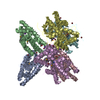
| ||||||||
|---|---|---|---|---|---|---|---|---|---|
| 1 |
| ||||||||
| Unit cell |
|
- Components
Components
-Orphan nuclear receptor NURR1 (MSE ... , 2 types, 6 molecules ADBCEF
| #1: Protein | Mass: 30670.041 Da / Num. of mol.: 2 Source method: isolated from a genetically manipulated source Source: (gene. exp.)  Homo sapiens (human) / Gene: NR4A2 OR NURR1 OR TINUR OR NOT / Plasmid: pET-15b / Production host: Homo sapiens (human) / Gene: NR4A2 OR NURR1 OR TINUR OR NOT / Plasmid: pET-15b / Production host:  #2: Protein | Mass: 30716.936 Da / Num. of mol.: 4 Source method: isolated from a genetically manipulated source Source: (gene. exp.)  Homo sapiens (human) / Gene: NR4A2 OR NURR1 OR TINUR OR NOT / Plasmid: pET-15b / Production host: Homo sapiens (human) / Gene: NR4A2 OR NURR1 OR TINUR OR NOT / Plasmid: pET-15b / Production host:  |
|---|
-Non-polymers , 4 types, 590 molecules 






| #3: Chemical | ChemComp-K / #4: Chemical | ChemComp-BR / #5: Chemical | ChemComp-IOD / | #6: Water | ChemComp-HOH / | |
|---|
-Details
| Has protein modification | Y |
|---|
-Experimental details
-Experiment
| Experiment | Method:  X-RAY DIFFRACTION / Number of used crystals: 1 X-RAY DIFFRACTION / Number of used crystals: 1 |
|---|
- Sample preparation
Sample preparation
| Crystal | Density Matthews: 2.3 Å3/Da / Density % sol: 46.54 % | |||||||||||||||||||||||||||||||||||||||||||||||||||||||||||||||
|---|---|---|---|---|---|---|---|---|---|---|---|---|---|---|---|---|---|---|---|---|---|---|---|---|---|---|---|---|---|---|---|---|---|---|---|---|---|---|---|---|---|---|---|---|---|---|---|---|---|---|---|---|---|---|---|---|---|---|---|---|---|---|---|---|
| Crystal grow | Temperature: 298 K / Method: vapor diffusion / pH: 6.5 Details: PEG3350,KBr, Hepes, pH 6.5, VAPOR DIFFUSION, temperature 298K | |||||||||||||||||||||||||||||||||||||||||||||||||||||||||||||||
| Crystal grow | *PLUS Temperature: 20 ℃ / pH: 7.9 / Method: vapor diffusion, hanging drop | |||||||||||||||||||||||||||||||||||||||||||||||||||||||||||||||
| Components of the solutions | *PLUS
|
-Data collection
| Diffraction | Mean temperature: 90 K |
|---|---|
| Diffraction source | Source:  SYNCHROTRON / Site: SYNCHROTRON / Site:  ALS ALS  / Beamline: 5.0.2 / Wavelength: 1.1 Å / Beamline: 5.0.2 / Wavelength: 1.1 Å |
| Detector | Type: ADSC QUANTUM 4 / Detector: CCD / Date: Nov 29, 2001 |
| Radiation | Monochromator: Double cyrstal Si(111) / Protocol: SINGLE WAVELENGTH / Monochromatic (M) / Laue (L): M / Scattering type: x-ray |
| Radiation wavelength | Wavelength: 1.1 Å / Relative weight: 1 |
| Reflection | Resolution: 2.2→34.7 Å / Num. all: 287222 / Num. obs: 82388 / % possible obs: 98.7 % / Observed criterion σ(F): 1 / Observed criterion σ(I): 1 / Rsym value: 0.072 / Net I/σ(I): 6.2 |
| Reflection shell | Resolution: 2.2→2.32 Å / Rmerge(I) obs: 0.269 / Mean I/σ(I) obs: 2.4 / % possible all: 91.7 |
| Reflection | *PLUS Num. measured all: 287222 / Rmerge(I) obs: 0.072 |
- Processing
Processing
| Software |
| |||||||||||||||||||||||||
|---|---|---|---|---|---|---|---|---|---|---|---|---|---|---|---|---|---|---|---|---|---|---|---|---|---|---|
| Refinement | Method to determine structure:  MAD / Resolution: 2.2→500 Å / σ(F): 0 / Stereochemistry target values: Engh & Huber MAD / Resolution: 2.2→500 Å / σ(F): 0 / Stereochemistry target values: Engh & Huber
| |||||||||||||||||||||||||
| Refinement step | Cycle: LAST / Resolution: 2.2→500 Å
| |||||||||||||||||||||||||
| Refine LS restraints |
| |||||||||||||||||||||||||
| Refinement | *PLUS % reflection Rfree: 5 % | |||||||||||||||||||||||||
| Solvent computation | *PLUS | |||||||||||||||||||||||||
| Displacement parameters | *PLUS |
 Movie
Movie Controller
Controller



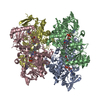


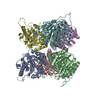
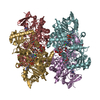
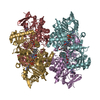

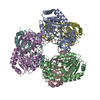
 PDBj
PDBj




